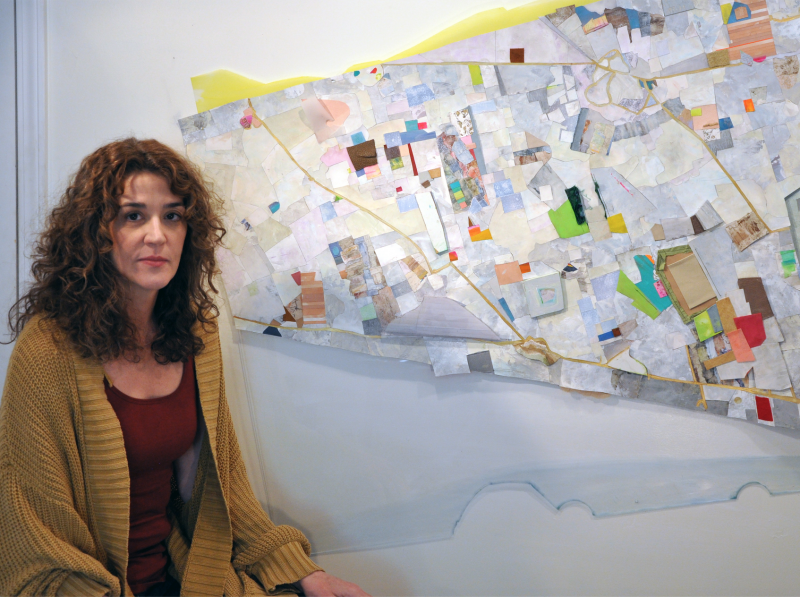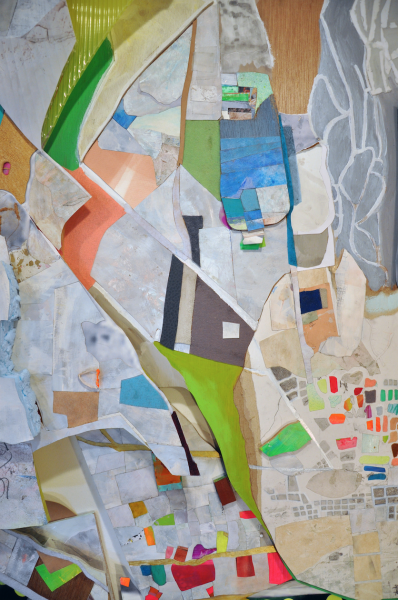Interview with Evanston Art Center Exhibiting Artist: Jennifer Mannebach

How will your upcoming Evanston Art Center exhibition differ from your previous work?
I like to focus on the borders and edges of where things collect, and the relationships between what happens on either side of these demarcations. As we are currently in the beginning of this Pandemic crisis, this interest in boundaries is resonating in ways that I’m still trying to work through.
Physically, the large wall piece I’m making is somewhat modular. Many of the working methods I've employed are familiar here, except that the diversity of materials is expanding with more dimensionality, like a garment wrapping, or furniture supporting a body. The piece is beginning to jut out into space with layers, linings, crevices and shadows. I’m playing with the ambiguity of this ‘map’,revealing/concealing things as I adapt: wedged in, off kilter, peeking out... lined and upholstered. I see areas that feel potentially eruptive, reminding me of notes wedged into crevices or talismanic textiles.
My plan for the window piece is similar to past work where I’ve used existing architectural glass for placement, but differs in my intention to use a material that will be cut to fit the precise window segments. I also plan to incorporate photographic elements of surrounding locations. (Given the current crisis, I’m not sure I can complete it as planned, but I hope so.)
Is your work site-specific? How does the location influence your artistic decisions?
The majority of my work is not, although I relish the opportunity when it arises. I’ve had large scale site-specific pieces at the Hyde Park Art Center and the Cook County Administration building. Last fall I participated in the Terrain Biennial with a site specific installation entitled ‘Transcription’ —referencing re-presentation (writing, music) as well as the biological crossing of boundaries in gene expression (DNA to RNA). This inspired me to think about the liminal spaces of home— blending private and public expression, finding discourse between the interior home and exterior environment. Influenced by cell diagrams and the visual language of molecular biology, I took photographs of small details within this home, thinking of these objects as visual touchstones for the family who lives there — the colors, textures and patterns as the DNA of the place that they inhabit. The resulting piece acted as a translucent screen or membrane installed in the transitionally charged space of their front porch.
How has your use of various media evolved over time?
My work is often hard for me to describe concisely because of the mixed material use. I guess it is collage in the sense of the abutment of material identities. About 10 years ago, I was making work exclusively with masking tape and powered graphite, often back-lit. The lines were created from the graphite drifting into the sticky edges of the tape. For some reason, I avoided additional color as a distraction to translucency, texture and line. Since then, my work has incorporated a wide range of color. It has evolved as my research has shifted. My use of color for recent bodies of work is inspired by the vibrant hue and chroma of microscopic visualization.
What are your other interests, and how do they influence or inspire your artistic practice?
Several years ago, I became fascinated by the advent of CRISPR Cas9 (gene editing) as a cogent parallel to the longstanding themes in my work examining fragments and boundaries conceptually and physically. Removing a snippet of information to redirect a protein creates a chain of events; likewise, the removal of a community, however small, reverberates into future generations, as does changing the location or character of a boundary between countries or even neighborhoods. I’ve spoken to a molecular biologist about some of these things and I would like to continue to cultivate these relationships; I’m looking forward to an art and science residency at Playa in Oregon this summer. My interest in maps, boundaries, fragments and uncertainty extends to personal hobbies such as beekeeping. It also informs how and where I choose to teach.

ABOUT CONCENTRICS

Concentrics is a quarterly interview series featuring EAC Exhibiting Artists, Faculty Members, Board Members and Students.
Find out how our faculty and board members started at EAC and why our students love it here. We want to give you a look into the community that makes up the Evanston Art Center!

